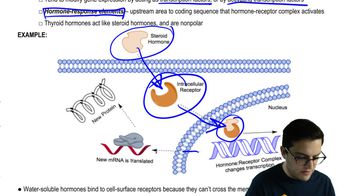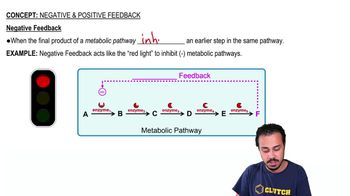The hypothalamus a. synthesizes all of the hormones produced by the pituitary gland. b. influences the function of only one lobe of the pituitary gland. c. produces only inhibitory hormones. d. regulates both reproduction and body temperature.
Ch. 45 - Hormones and the Endocrine System
Chapter 45, Problem 1
Which statement is accurate? (A) Hormones that differ in effect reach their target cells by different routes through the body. (B) Pairs of hormones that have the same effect are said to have antagonistic functions. (C) Hormones are often regulated through feedback loops. (D) Hormones of the same chemical class usually have the same function

Verified Solution
Video duration:
2mWas this helpful?
Key Concepts
Here are the essential concepts you must grasp in order to answer the question correctly.
Hormonal Signaling
Hormonal signaling involves the release of hormones into the bloodstream, where they travel to target cells to elicit specific responses. Different hormones can have varying effects on different tissues, and they may utilize distinct pathways to reach their targets, highlighting the complexity of endocrine communication.
Recommended video:
Guided course

Hormone Signaling
Feedback Mechanisms
Feedback mechanisms are regulatory processes that maintain homeostasis in the body. In hormonal regulation, feedback loops can be either positive or negative, where negative feedback reduces hormone production in response to high levels, while positive feedback amplifies the response, ensuring precise control over physiological functions.
Recommended video:
Guided course

Negative Feedback
Hormone Classification
Hormones can be classified based on their chemical structure, such as steroids, peptides, or amines. While hormones of the same class may share similar properties, they do not necessarily have the same functions, as their effects depend on the specific receptors they bind to and the target tissues involved.
Recommended video:
Guided course

Plant Hormones and Senescence
Related Practice
Textbook Question
933
views
Textbook Question
Growth factors are local regulators that a. are produced by the anterior pituitary. b. are modified fatty acids that stimulate bone and cartilage growth. c. are found on the surface of cancer cells and stimulate abnormal cell division. d. bind to cell-surface receptors and stimulate growth and development of target cells.
864
views
Textbook Question
Which hormone is correctly paired with its action? (A) oxytocin—stimulates uterine contractions during childbirth (B) thyroxine—inhibits metabolic processes (C) ACTH—inhibits the release of glucocorticoids by the adrenal cortex (D) melatonin—raises blood calcium level
1652
views
